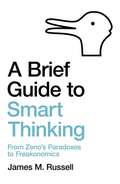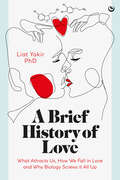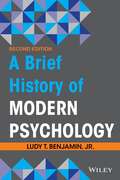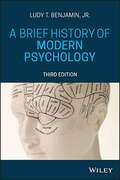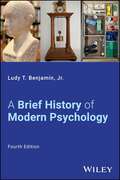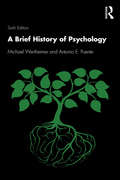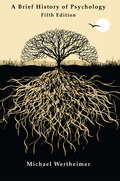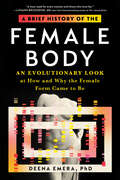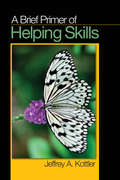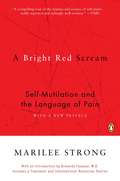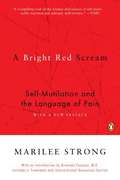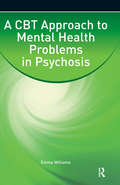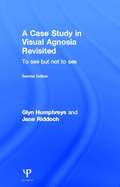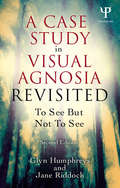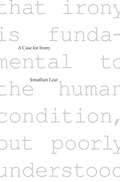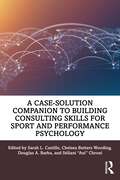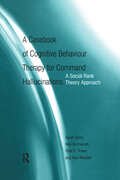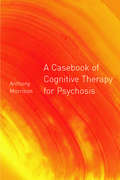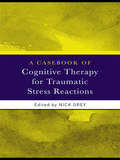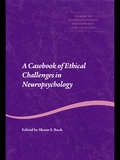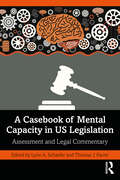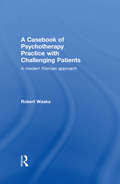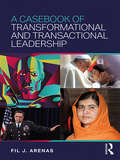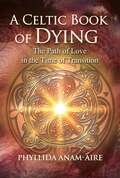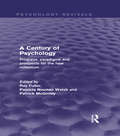- Table View
- List View
A Brief Guide to Smart Thinking: From Zeno’s Paradoxes to Freakonomics
by James M. RussellEach book is summarised to convey a brief idea of what each one has to offer the interested reader, while a 'Speed Read' for each book delivers a quick sense of what each book is like to read and a highly compressed summary of the main points of the book in question. The titles covered include thought-provoking classics on psychology, mindfulness, rationality, the brain, mathematical and economic thought and practical philosophy. The selection includes books about self-improvement as well as historically interesting accounts of how the mind works. Titles included go back as far as the Epictetus classic The Enchiridion and Bertrand Russell's charming The ABC of Relativity, and proceed through classics such as Edward de Bono's Lateral Thinking and into the digital era with titles such as The Shallows and Big Data. The books are arranged chronologically, which draws attention to some of the interesting juxtapositions and connections between them. Some of the titles included are: Freakonomics, by Steven D. Levitt; Blink: The Power of Thinking Without Thinking, by Malcolm Gladwell; Sapiens: A Brief History of Humankind, by Yuval Noah Harari; The Organized Mind: Thinking Straight in the Age of Information Overload, by Daniel J. Levitin; The Descent of Man, by Grayson Perry; How the Mind Works, by Steven Pinker; Black Box Thinking: Why Some People Never Learn from Their Mistakes - But Some Do, by Matthew Syed; We Should All Be Feminists, by Chimamanda Ngozi Adichie; Guns, Germs, and Steel: The Fates of Human Societies, by Jared Diamond; The Black Swan: The Impact of the Highly Improbable, by Nassim Nicholas Taleb; Man's Search for Meaning, by Viktor E. Frankl; The News: A User's Manual, by Alain de Botton; Mindware: Tools for Smart Thinking, by Richard E. Nisbett; The ABC of Relativity, by Bertrand Russell; The Psychopath Test, by Jon Ronson; The Path: What Chinese Philosophers Can Teach Us About the Good Life, by Michael Puett; A Brief History of Time, by Stephen Hawking; Messy: The Power of Disorder to Transform Our Lives, by Tim Harford; Big Data: A Revolution That Will Transform How We Live, Work, and Think, by Viktor Mayer-Schönberger; Moneyball: The Art of Winning an Unfair Game, by Michael Lewis; The Survivors Club: The Secrets and Science That Could Save Your Life, by Ben Sherwood; Black Box Thinking, by Matthew Syed; Chaos: Making a New Science, by James Gleick; A Short History of Nearly Everything, by Bill Bryson; The Shallows: What the Internet Is Doing to Our Brains, by Nicholas Carr; Making Ideas Happen: Overcoming the Obstacles Between Vision and Reality, by Scott Belsky; The Enchiridion, by Epictetus; Gödel, Escher, Bach, by Douglas R. Hofstadter; What I Talk About When I Talk About Running, by Haruki Murakami; and Lateral Thinking, by Edward de Bono.
A Brief History of Love: What Attracts Us, How We Fall in Love and Why Biology Screws it All Up
by Liat YakirIs love about chemistry or do biology, evolution and psychology all have a part to play?Love is one of the most complex and confusing emotions in the human experience. It consumes so much of our lives and yet we don&’t truly understand it – what it is on a biological, chemical and evolutionary level. This book takes you on a fascinating journey to explore the science of love, looking closely at the interplay between genes, hormones, emotions and relationships.Discover everything you need to know about why you are attracted to certain people, the brain&’s role in your emotions, how to pick &“the one&” and how to preserve that love over time. Learn how to have better, healthier and more loving relationships by understanding the inner workings of love in your body.
A Brief History of Modern Psychology
by Ludy T. BenjaminIn A Brief History of Modern Psychology 2nd Edition, Ludy Benjamin, a leading historian in the field, discusses the history of both the science and the practice of psychology since the establishment of the first experimental psychology laboratory in 1879. In engaging prose, this book weaves together the historical and disciplinary context that will help readers to better understand the richness and complexity of contemporary psychology. In the Second Edition, personality, social, and developmental psychology are expanded upon, providing balanced coverage of these three topics.
A Brief History of Modern Psychology
by Ludy T. BenjaminA Brief History of Modern Psychology offers a concise account of the evolution of this dynamic field―from early pioneers of psychological theory to cutting-edge contemporary applications. In this revised third edition, leading scholar Ludy Benjamin surveys the significant figures, concepts, and schools of thought that have shaped modern psychology. Engaging and accessible narrative provides readers historical and disciplinary context to modern psychology and encourages further investigation of the topics and individuals presented. This book provides a solid foundational knowledge of psychology’s past, covering essential areas including prescientific psychology, physiology and psychophysics, early schools of German and American psychology, and the origins of applied psychology, behaviorism, and psychoanalysis. Exploration of 20th century and contemporary developments, including the emergence of clinical and cognitive psychology, ensures a complete overview of the field. <p><p> The author integrates biographical information on widely recognized innovators such as Carl Jung, Wilhelm Wundt, and B.F. Skinner with lesser known figures including E.B. Titchener, Mary Calkins, and Leta Hollingworth. This personalistic approach to history allows readers to understand the theories, research, and practices of the individuals who laid the foundation to modern psychology.
A Brief History of Modern Psychology
by Ludy T. Benjamin Jr.A Brief History of Modern Psychology is a clear and engaging account of scientific psychology’s origins, evolution, and related professional practice. With a reader-friendly narrative style, author Ludy Benjamin provides the historical and disciplinary context needed to appreciate the richness and complexity of contemporary psychology. Concise chapters apply biographical and historical context to individual psychologists while exploring pre-scientific psychology, physiology and psychophysics, early schools of German and American psychology, applied psychology, behaviorism, psychoanalysis, cognitive psychology, and more. Thoroughly revised and updated to reflect current scholarship in the field, the fourth edition of A Brief History of Modern Psychology contains new examinations of the connections between phrenology and modern neuroscience, the dangers and proliferation of bogus therapies, industrial psychology, eugenics, intelligence testing, sport psychology, and more. Expanded coverage includes Hermann von Helmholtz’s research on the speed of nerve conductance, Christine Ladd-Franklin’s theory of color vision, Charles Darwin’s theory of natural selection and its widespread influence on psychology, Sigmund Freud’s impact in America, Charles Henry Turner’s pioneering work in comparative psychology, and Evelyn Hooker’s work that led to the removal of “homosexuality” as a mental disorder from the DSM.
A Brief History of Psychology
by Michael Wertheimer Antonio E. PuenteThis brief, inexpensive text offers great flexibility in teaching the history of psychology. Used as a stand-alone text or with readers, this engaging book is noted for its analysis of the scientific and philosophical emergence of the field as well as its coverage of contemporary psychology and emerging areas. Readers appreciate the book's balanced coverage of experimental, applied, and clinical psychology, as well as the clear and succinct presentation of the field's major events and schools of thought. The sixth edition features an expanded pedagogical program with bolded terms, a complete glossary, more illustrations, and web-based instructional materials including PowerPoints, a test bank, discussion questions, and more. Special emphasis has also been placed on the role of the American Psychological Association (APA) in the history of psychology.Extensively updated throughout, the sixth edition features: A revised final chapter with a current analysis of the state of the field, including the growth of the APA as well as specialized organizations that promote the science and profession of psychology, and the push to influence policies that address global challenges, such as environmental sustainability, intergroup conflict, health disparities, and the population explosion. A discussion of the growth in the number and role of women and ethnic minorities in psychology, and the promotion of diversity across both demographic and intellectual perspectives. Recent developments in the growth of neuroscience, cognitive science, artificial intelligence, and the diversification and internationalization of psychology. Portraits of some major figures in the history of psychology, including psychology’s first Nobel Prize winners. Recent and evolving changes in the practice of psychology, including more emphasis on "evidence-based practice," prescription privileges, and the emergence of the importance of psychological practice in health care. Recent changes in the APA, including new divisions and new elected officials and its emerging focus on advocacy. Used independently or as a supplement with readers, this brief text is intended for undergraduate and graduate courses on the history of psychology. Due to its brevity and engaging style, the book can be used in introductory courses to introduce students to the field. The enormous index and substantial glossary make this volume a useful desk reference for psychology and related disciplines.
A Brief History of Psychology
by Michael WertheimerThis brief, inexpensive text offers the utmost in flexibility in teaching the history of psychology. Used as a stand-alone text or with readers, this engaging book is noted for its analysis of the scientific and philosophical emergence of the field. Readers appreciate the book’s balanced coverage of experimental, applied, and clinical psychology, as well as the clear and succinct presentation of the field’s major events and schools of thought. This edition features an expanded pedagogical program with bolded terms, a complete glossary, more illustrations, and web-based instructional materials including Power Points, a test bank, discussion questions, and more. Extensively updated throughout, this edition features: A new final chapter with a current analysis of the state of the field including the growth of specialized organizations that promote the science of psychology and the push to influence policies that address global challenges such as environmental sustainability, intergroup conflict, health disparities, and the population explosion. A discussion of the growth in the number and role of women in psychology and the promotion of diversity initiatives related to ethnicity, gender, age, and sexual orientation. Recent developments in the growth of neuroscience, cognitive science, and the diversification of psychology. Portraits of some major figures in the history of psychology. Recent changes in the practice of psychology including more emphasis on "evidence-based practice," prescription privileges, and the application of psychological principles to industrial and engineering psychology. Recent changes in the APA including new divisions and new elected officials. Used independently or as a supplement with readers, this brief text is intended for undergraduate and graduate courses on the history of psychology. Due to its brevity and engaging style, the book is often used in introductory courses to introduce students to the field. The enormous index and substantial glossary make this volume a useful desk reference for the entire field.
A Brief History of the Female Body: An Evolutionary Look at How and Why the Female Form Came to Be
by Dr. Deena EmeraFrom breasts and orgasms to periods, pregnancies, and menopause—A Brief History of the Female Body is a fascinating science book explaining the mysteries of the female body through an evolutionary lens.Let's face it: The female body is an enigma. For teenagers first experiencing their periods, the monthly arrival of mood swings and cramps can be agonizing and inconvenient. With pregnancy—perhaps the most miraculous of bodily events—comes countless potential complications, including high blood pressure, diabetes, premature birth, and postpartum depression. And menopause is equally mystifying. Why do females lose their fertility over time and experience the notorious side effects—like hot flashes, weight gain, and hair loss—while males maintain their fertility forever?Evolutionary geneticist and educator Dr. Deena Emera has spent much of her career studying the evolution of female reproduction. A Brief History of the Female Body draws on her vast expertise as a biologist, her experience as a mother of four children, and her love of teaching to look far into our evolutionary past, illuminating how and, more importantly, why the female form has transformed over millions of years and its effects on women's health.
A Brief Primer of Helping Skills
by Dr Jeffrey A. KottlerA Brief Primer of Helping Skills is a highly readable, accessible, and practical introduction to the skills of helping and making a difference in people's lives. In an engaging and concise style, author Jeffrey A. Kottler gives students in various professions an overview of the theory, process, and skills of helping methods. It is designed as an operating manual for those in human service professions to learn the basics involved in developing helping relationships, assessing and diagnosing complaints, promoting exploration and understanding, and designing and implementing action plans.Key FeaturesOffers a brief introduction to the helping process: Written in an accessible and conversational style, this book helps students and professionals become familiar with the basic process quickly.Provides personal applications: This book helps students enrich their lives while learning how to be more helpful to others.Includes applications to a variety of settings and disciplines: Students can actually use material and skills in the book in all the various domains in which they function—at work, in volunteer agencies, with friends and family. Uses an integrative approach: The best features of all major theories and research are combined into a unified model of helping that is responsive to different needs.Intended AudienceThis supplemental text is ideal for introductory undergraduate and graduate courses such as Introduction to Social Work, Introduction to Counseling, and Introduction to Human Services in the fields of counseling, psychology, human services, social work, education, family studies, marital and family therapy, pastoral work, nursing, human resource development, and other helping professions. It is also an excellent resource for beginning practitioners.
A Bright Red Scream: Self-Mutilation and the Language of Pain
by Marilee StrongSelf-mutilation is a behavior so shocking that it is almost never discussed. Yet estimates are that upwards of eight million Americans are chronic self-injurers. They are people who use knives, razor blades, or broken glass to cut themselves. Their numbers include the actor Johnny Depp, Girl Interrupted author Susanna Kaysen, and the late Princess Diana. Mistakenly viewed as suicide attempts or senseless masochism--even by many health professionals--"cutting" is actually a complex means of coping with emotional pain. Marilee Strong explores this hidden epidemic through case studies, startling new research from psychologists, trauma experts, and neuroscientists, and the heartbreaking insights of cutters themselves--who range from troubled teenagers to middle-age professionals to grandparents. Strong explains what factors lead to self-mutilation, why cutting helps people manage overwhelming fear and anxiety, and how cutters can heal both their internal and external wounds and break the self-destructive cycle. A Bright Red Scream is a groundbreaking, essential resource for victims of self-mutilation, their families, teachers, doctors, and therapists.
A Bright Red Scream: Self-mutilation and the Language of Pain
by Marilee StrongSelf-mutilation is a behaviour so shocking that it is almost never discussed. Yet millions of people all over the world are chronic self-injurers. They are people who use knives, razor blades, or broken glass to cut themselves and their numbers include Johnny Depp and the late Princess Diana. In this groundbreaking work - an essential resource for victims, parents and therapists - Strong explores this hidden epidemic through case studies, research from psychologists, trauma experts, and the cutters themselves. It is a compelling tour of the trauma and science of self-injury.
A CBT Approach to Mental Health Problems in Psychosis
by Emma WilliamsThis book draws together advances in the understanding, assessment and treatment of stress, negative symptoms, social anxiety, OCD, PTSD and mood disturbance in people with a diagnosis of psychosis, providing a practical guide for clinicians. CBT for psychosis draws on the principles and interventions developed for anxiety and depression and adapts these to treat psychotic symptoms. CBT for schizophrenia is now widely accepted as an effective treatment in the reduction of psychotic symptoms. A review of findings led the National Institute for Health and Clinical Excellence (NICE) to recommend offering CBT to all people with schizophrenia. Content includes: the role of stress in psychosis; negative symptoms - emotional, motivational and behavioural deficits; social anxiety disorder; obsessional compulsive disorder; post-traumatic stress disorder; mood disturbance in psychosis; and client handouts. It features: 174 pages, perfect bound (246 x 171mm).
A Case Study in Visual Agnosia Revisited: To See But Not To See
by Glyn W. Humphreys Jane RiddochVisual agnosia is a rare but fascinating disorder of visual object recognition that can occur after a brain lesion. This book documents the case of John, who worked intensively with the authors for 26 years after acquiring visual agnosia following a stroke. It revisits John's case over twenty years after it was originally described in the book To See But Not To See, in 1987. As in the previous book, the condition is illuminated by John and his wife, Iris, in their own words.
A Case Study in Visual Agnosia Revisited: To see but not to see
by Jane Riddoch Glyn HumphreysVisual agnosia is a rare but fascinating disorder of visual object recognition that can occur after a brain lesion. This book documents the case of John, who worked intensively with the authors for 26 years after acquiring visual agnosia following a stroke. It revisits John’s case over twenty years after it was originally described in the book To See But Not To See, in 1987. As in the previous book, the condition is illuminated by John and his wife, Iris, in their own words. A Case Study in Visual Agnosia Revisited discusses John’s case in the context of research into the cognitive neuroscience of vision over the past twenty years. It shows how John’s problems in recognition can provide important insights into the way that object recognition happens in the brain, with the results obtained in studies of John’s perception being compared to emerging work from brain imaging in normal observers. The book presents a much fuller analysis of the variety of perceptual problems that John experienced, detailing not only his impaired object recognition but also his face processing, his processing of different visual features (colour, motion, depth), his ability to act on and negotiate his environment, and his reading and writing. A Case Study in Visual Agnosia Revisited will be a key reference for those concerned with understanding how vision is implemented in the brain. It will be suitable for both undergraduate students taking courses in cognitive psychology and neuropsychology, and also researchers in the cognitive neuroscience of vision. The presentation of John’s case, and the human aspects of the disorder, will also be of great interest to a general audience of lay people interested in perception.
A Case for Irony (The Tanner lectures on human values #13)
by Jonathan LearIn 2001, Vanity Fair declared that the Age of Irony was over. Joan Didion has lamented that the United States in the era of Barack Obama has become an "irony-free zone." Jonathan Lear in his 2006 book Radical Hope looked into America’s heart to ask how might we dispose ourselves if we came to feel our way of life was coming to an end. Here, he mobilizes a squad of philosophers and a psychoanalyst to once again forge a radical way forward, by arguing that no genuinely human life is possible without irony. Becoming human should not be taken for granted, Lear writes. It is something we accomplish, something we get the hang of, and like Kierkegaard and Plato, Lear claims that irony is one of the essential tools we use to do this. For Lear and the participants in his Socratic dialogue, irony is not about being cool and detached like a player in a Woody Allen film. That, as Johannes Climacus, one of Kierkegaard’s pseudonymous authors, puts it, “is something only assistant professors assume.” Instead, it is a renewed commitment to living seriously, to experiencing every disruption that shakes us out of our habitual ways of tuning out of life, with all its vicissitudes. While many over the centuries have argued differently, Lear claims that our feelings and desires tend toward order, a structure that irony shakes us into seeing. Lear’s exchanges with his interlocutors strengthen his claims, while his experiences as a practicing psychoanalyst bring an emotionally gripping dimension to what is at stake—the psychic costs and benefits of living with irony.
A Case-Solution Companion to Building Consulting Skills for Sport and Performance Psychology (Building Consulting Skills for Sport and Performance Psychology)
by Chelsea Butters Wooding Douglas A. Barba Stiliani “Ani” Chroni Sarah L. CastilloThis international compilation offers a range of potential solutions to case studies that cover pertinent issues within a variety of performance environments. Offering a companion text to Building Consulting Skills for Sport and Performance Psychology: An International Case Study Collection, this book provides three solutions for each of the case studies introduced. In so doing, it highlights that there is no "one-answer-fits-all" solution to the common issues with sport and performance psychology consulting and offers various suggestions for how an individual may wish to approach these and similar cases. Solutions address the CEDI principles (Case Conceptualization, Ethical Considerations, Diversity Awareness/Reflection, and Intervention Planning and Evaluation), as well as any case-specific questions. This clearly structured book serves as a useful resource for instructors looking to deepen discussion and offer alternatives to students’ ideas on how to approach certain cases. It will also be of interest to practitioners when approaching similar situations in their own work and looking for new pathways that they may not have considered.
A Casebook of Cognitive Behaviour Therapy for Command Hallucinations: A Social Rank Theory Approach
by Sarah Byrne Max Birchwood Alan Meaden Peter E. TrowerCommand hallucinations are a particularly distressing and sometimes dangerous type of hallucination about which relatively little is known and for which no evidenced based treatment currently exists. In A Casebook of Cognitive Behaviour Therapy for Command Hallucinations the development of a new and innovative evidence based cognitive therapy is presented in a practical format ideal for the busy practitioner. This new approach is based on over a decade's research on the role of voice hearers' beliefs about the power and omnipotence of their voices and how this drives distress and 'acting on' voices. The therapy protocol is presented in clear steps from formulation to intervention. The body of the book describes its application in eight cases illustrating the breadth of its application, including 'complex' cases. The authors also present their interpretation of what their findings tell us about what works and doesn't work, and suggestions for future developments. Subjects covered also include: understanding command hallucinations a cognitive versus a quasi-neuroleptic approach to CBT in psychosis does CBT for CH work? findings from a randomised controlled trial. This book provides a fascinating and very practical summary of the first intervention to have a major impact on distress and on compliance with command hallucinations. It will be of great interest to all mental health practitioners working with people with psychosis in community and forensic settings.
A Casebook of Cognitive Therapy for Psychosis
by Anthony P. MorrisonThis book is a unique volume in which leading clinicians and researchers in the field of cognitive therapy for psychosis illustrate their individual approaches to the understanding of the difficulties faced by people with psychosis and how this informs intervention.Chapters include therapies focused on schizophrenia and individual psychotic symptoms such as hallucinations and delusions (including paranoia). Beck's original case study of cognitive therapy for psychosis from 1952 is reprinted, accompanied by his 50-year retrospective analysis. Also outlined are treatments for:• bipolar disorder • dual diagnosis • schema-focused approaches • early intervention to prevent psychosis • adherence to medicationThis book will be useful to clinicians and researchers alike, and will be an invaluable resource to mental health practitioners working with individuals experiencing psychosis.
A Casebook of Cognitive Therapy for Traumatic Stress Reactions
by Nick GreyMany people experience traumatic events and whilst some gradually recover from such experiences, others find it more difficult and may seek professional help for a range of problems. A Casebook of Cognitive Therapy for Traumatic Stress Reactions aims to help therapists who may not have an extensive range of clinical experience. The book includes descriptions and case studies of clinical cases of cognitive behavioural treatments involving people who have experienced traumatic events, including: people with phobias, depression and paranoid delusions following traumatic experiences people with Posttraumatic Stress Disorder (PTSD) people who have experienced multiple and prolonged traumatizations people who are refugees or asylum-seekers. All chapters are written by experts in the field and consider what may be learned from such cases. In addition it is considered how these cases can be applied more generally in cognitive behavioural treatments for traumatic stress reactions. This book will be invaluable to all mental health professionals and in particular to therapists wanting to treat people who have experienced traumatic events, allowing them to creatively apply their existing knowledge to new clinical cases.
A Casebook of Ethical Challenges in Neuropsychology (Studies on Neuropsychology, Development, and Cognition)
by Shane S. BushThe American Psychological Association published a revision of the Ethical Principles of Psychologists and Code of Conduct in 2002.This text, a companion to the 2002 text Ethical Issues in Clinical Neuropsychology by Bush and Drexler, presents the reader with common ethical challenges in neuropsychology. This text examines the differences between the 1992 and 2002 APA Ethics Codes as they relate to neuropsychological activities.The authors present cases and discuss ethical issues related to neuropsychological practice with a variety of patient populations and in a variety of clinical settings. In addition, ethical issues in neuropsychological research and test development are examined. The text also includes chapters on emerging and particularly challenging aspects of neuropsychological practice, such as the assessment of response validity, and the use of information technology and telecommunications. Through the use of case illustrations, the authors examine ethical issues in neuropsychology and the new Ethics Code, offering a practical approach for understanding and promoting ethical neuropsychological practice.
A Casebook of Mental Capacity in US Legislation: Assessment and Legal Commentary
by Thomas J. Farrer Lynn A. SchaeferA Casebook of Mental Capacity in US Legislation: Assessment and Legal Commentary employs an applied and accessible approach to the assessment of mental capacity. Through the use of rich vignettes and case examples, the text provides legal commentary to illustrate state laws and ethical principles from varied decision-making capacities in distinct settings to fortify its assessment. The text begins by providing a background about decision-making capacity as a construct. It also provides practical guidance on capacity assessment germane to a broad range of clinical settings, including geropsychology, health psychology, and neuropsychology. It moves on to reviewing decision-making rights that make up capacity, and provides ethical guidelines while drawing the practitioner’s attention to the common pitfalls. The case presentations and legal commentary underline key areas such as the capacity to consent to medical treatment, make welfare decisions, enter into a sexual relationship, make financial decisions, create or revoke a will, litigate and contract, and stand trial. It also includes a chapter focusing on integrating culture and diversity in capacity evaluations with the aim of increasing the practitioner’s competence. This casebook will be useful for clinical psychologists in practice, researchers and students seeking to understand how to perform capacity assessments, as well as other related healthcare professionals. It is further aimed at legal professionals to utilize as a reference that details how individual types of capacity are defined and assessed.
A Casebook of Psychotherapy Practice with Challenging Patients: A modern Kleinian approach
by Robert WaskaMost contemporary psychoanalysts and psychotherapists see each patient once or twice a week at most. As many patients have reached a marked state of distress before seeking treatment, this gives the analyst a difficult task to accomplish in what is a limited amount of time. A Casebook of Psychotherapy Practice with Challenging Patients: A modern Kleinian approach sets out a model for working with quite significantly disturbed, distressed, or resistant patients in a very limited time, which Robert Waska has termed "Modern Kleinian Therapy." Each chapter provides a vivid look into the moment-to-moment workings of a contemporary Kleinian focus on understanding projective identification, enactment, and acting out as well as the careful and thoughtful interpretive work necessary in these complex clinical situations. Individual psychotherapeutic work is represented throughout the book alongside instructive reports of psychoanalytic work with disturbed couples, and the more challenging patient is illustrated with several comprehensive reviews of films that follow such hard-to-reach individuals. A Casebook of Psychotherapy Practice with Challenging Patients: A modern Kleinian approach is filled with a combination of contemporary theory building, a wealth of clinical vignettes, and practical advice. It is a hands-on guide for psychoanalysts and therapists who need to get to grips with complex psychoanalytic concepts in a short time and shows the therapeutic power the Modern Kleinian Therapy approach can have and how it can enable them to work most effectively with difficult patients. Robert Waska LPCC, MFT, PhD is an analytic member at the San Francisco Center for Psychoanalysis and conducts a full-time private psychoanalytic practice for individuals and couples in San Francisco and Marin County, California. He is the author of thirteen published textbooks on Kleinian psychoanalytic theory and technique, is a contributing author for three psychology texts, and has published over a hundred articles in professional journals.
A Casebook of Transformational and Transactional Leadership
by Fil J. ArenasFeaturing more than twenty-five case studies of leaders throughout history, A Casebook of Transformational and Transactional Leadership supplements existing texts on transformational leadership and the full range model to promote higher levels of understanding of transformational and transactional leadership behaviors. Beginning with an overview of transformational and transactional behavior components, Arenas describes the original tenets of leadership researchers, demonstrating how practicing the principles of full range leadership can aid those who guide or manage others. The subsequent chapters examine influential figures from various organizational environments to provide readers with examples that connect with core full range leadership concepts. Finally, each chapter ends with a discussion question, helping to engage students with the material and encouraging further reflection and study. A Casebook of Transformational and Transactional Leadership is essential reading for both graduate and undergraduate students of leadership development, as well as military and non-military professionals in leadership, leadership development, business and management, and education.
A Celtic Book of Dying: The Path of Love in the Time of Transition
by Phyllida Anam-Áire• Describes the Celtic rituals of honoring death and dying and offers prayers, meditations, and blessings for the time of transition • Offers reflective questions and exercises to explore your beliefs, attitudes, and fears around your own death • Includes the sacred meditation of traveling with the dead as offered by an anam-áire or Celtic soul carer Through her decades of hospice work, Phyllida Anam-Áire has revived the ancient Celtic tradition of &“watching&” with the dying and traveling with the soul after death. Drawing on her Celtic background, she integrates the wisdom of her ancestors with modern knowledge of the death process. She shows how a peaceful transition for the leaving person is possible and how this process can be consciously supported for relatives or friends. In A Celtic Book of Dying, Phyllida details the Celtic rituals of honoring death and dying, revealing how these rituals act as a catalyst that allows the change of form for our essence to pass on into the afterlife. She shows how becoming familiar with the dying process and acknowledging our own personal death forms an important aspect of preparing for this natural transformation. The author guides us with reflective questions, exercises, and meditations to help us become aware of and evaluate our own beliefs, attitudes, and fears around dying and learn to live our life more consciously and with joy. Once we have come to terms with our own passing, we will also find it easier to assist family and friends in their last hours. Phyllida presents the sacred meditation of traveling with the dead as held by an anam-áire or soul carer. She also offers suggestions for Celtic rituals, prayers, and blessings for support. She addresses many practical questions around care for the dying during and after the process, including the importance of silence. A practical yet soulful guidebook, A Celtic Book of Dying deepens our spiritual understanding of the internal journey of the dying and the adventurous after-death journey to come. Through the eyes of an anam-áire, we see death not as the end or something to be feared, but just as the moment of being called home again.
A Century of Psychology: Progress, paradigms and prospects for the new millennium (Psychology Revivals)
by Patricia Noonan Walsh Patrick McGinley Ray FullerPsychology has influence in almost every walk of life. Originally published in 1997, A Century of Psychology is a review of where the discipline came from, where it had reached and where the editors anticipated it may go. Ray Fuller, Patricia Noonan Walsh and Patrick McGinley assembled an internationally recognised team of mainly European experts from the major applications and research areas of psychology. They begin with a critical review of methodology and its limitations and plot the course of gender and developmental psychology. They go on to include discussion of learning, intellectual disability, clinical psychology and the emergence of psychotherapy, educational psychology, organizational psychology, cognitive psychology, neuropsychology and many other topics, in particular community psychology, perception and alternative medicine. Enlightening, reflective and sometimes provocative, A Century of Psychology is required reading for anyone involved in psychology as a practitioner, researcher or teacher. It is also a lively introduction for those new to the discipline.
